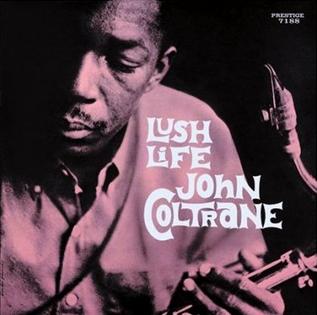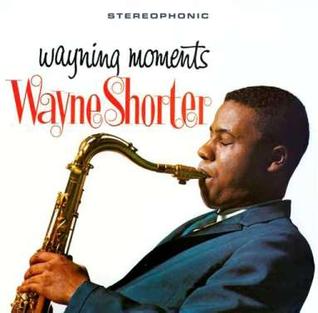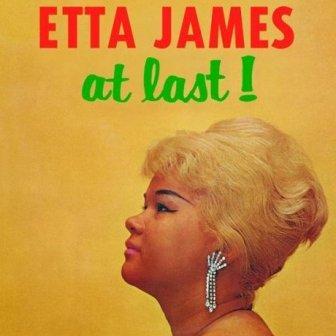Recent listening, current
Archived listening, 2013-2016
Showing posts with label 1961. Show all posts
Showing posts with label 1961. Show all posts
Thursday, January 23, 2014
170-173. Four albums by Gigi Gryce Quintet and Gigi Gryce Orch-Tette, 1960-1961
This CD release by Fresh Sound collects the last four LPs by Gigi Gryce: Saying Somethin'; The Hap'nin's; The Rat Race Blues; and Reminiscin'. I think they were originally released on Jazzland, but I have to double-check. Gryce was respected and admired as an altoist and composer, and he is heard on a good many dates by other leaders. But he left performing and recording for the field of education... PS 53 in the Bronx, to be precise. In that regard, he reminds me of people like Nathan Davis, Donald Byrd, or Dave Van Kriedt who quit the scene to become educators. Sadly, Gryce's memory gets lost, because in an age of new ideas, he just kept on playing hard bop and never really made a big splash. What he didn't accomplish by comparison to his peers is irrelevant. As this set shows, Gryce made some excellent music. His effortless, sometimes abrasive lines and unique approach to the blues are rock solid. I know everyone's blues is unique but it's nice to hear a person say it his way. Likewise, Gryce's arrangements of "Summertime," "A Train," "Lover Man," and "Caravan" put a vivid new spark into the old warhorses. I'm thankful we have the recordings he left and if you haven't heard of him, then you now have a new musician to look into.
Monday, January 6, 2014
167. John Coltrane / Lush Life (1961)
While Prestige's Lush Life was not released until 1961, it was recorded by Van Gelder during three sessions in '57 and '58. As he was no longer recording for the label, Coltrane had no say in it but ironically, the record contains a few of his choicest recordings playing in the small group, hard bop setting. This was an incredibly fertile period for Coltrane. He had yet to compose the seminal works that later appeared on Blue Note and Atlantic but was already working on the technique and musical ideas that would define his legacy. The first three tracks present Coltrane as leader of a pianoless trio, fleshing out a lot of chords in lieu of the keyboard. The most memorable moment on Lush Life is probably the title track, a luscious ballad owned by the leader until around nine minutes in when Donald Byrd steps out of the woodwork for some equally inspiring lines on the trumpet. Two years ago I was at a stoplight listening to this on the radio and was so transfixed by Byrd's meandering melancholy that it took a horn blast from the car behind me to break the reverie. While I'll never recreate that moment, I can still listen again and again. "Trane's Slo Blues" is also notable for Coltrane's moves inside the changes. These tracks appear on the boxset Fearless Leader although they are not presented in the same sequence as they are here, which is actually quite good.
Labels:
1957,
1958,
1961,
albert heath,
art garland,
art taylor,
donald byrd,
earl may,
hard bop,
john coltrane,
louis hayes,
lush life,
paul chambers,
prestige,
quintet,
tenor,
tenor sax,
tenor saxophone,
trio,
trumpet
Tuesday, December 3, 2013
154. Gene Ammons and Sonny Stitt / Boss Tenors (1961)
If you've got the stereo disc then Ammons is in the right channel and usually goes first. Stitt is in the left channel and comes next, occasionally doubling on alto. The latter was one of the most inspiring alto players there was, but he gets short shrift. A whiz on the alto, he was equally capable on tenor or even baritone (no barisax on this disc). These two players make wonderful music together. It's a solid dance session, with plenty of fireworks and some intriguing knots in the choruses that may interest more serious listeners. "There is No Greater Love" features Stitt on alto. His exhilirating double-time chourses are a thing to marvel at. While trading jabs with each other, the horns take unexpected sidesteps outside the blues, like in Ammons' first chorus of "Autumn Leaves," or some of Stitt's phrases in the smoking "Blues Up and Down." The rhythm section of John Houston, Buster Williams, and George Brown has a good chemistry. Williams' timekeeping meshes well with Brown, and especially Houston's comping style, which favors chunky, chorded statements emphasizing the beat. Their interplay with the leaders during "Blues Up and Down" really kicks the tune into a higher gear. This is a memorable session, and quite enjoyable, to say the least.
Labels:
1961,
alto,
alto saxophone,
boss tenors,
buster williams,
chicago,
gene ammons,
george brown,
hard bop,
jazz,
john houston,
quintet,
review,
sonny stitt,
tenor sax,
tenor saxophone,
verve
Tuesday, November 19, 2013
151. Hank Mobley / Workout (1961)
The band is Mobley with Wynton Kelly, Paul Chambers, and Philly Joe Jones playing typically of the period. I can't help but feel that Mobley is underrated as a composer and stylist, though. He's in that club with George Coleman and a few others, seemingly overshadowed by the giants they came up with. There's a lot of blues on this record, dotted here and there with elastic phrases and effervescent flurries by Mobley. Four of the six tunes are Mobley's originals, the exceptions being "The Best Things in Life are Free" and "Three Coins in the Fountain." They're interesting covers, one being rather old and the other an oddball. I like Mobley's melodic inventions and improvised embellishments of the melody. His colorful palette combined with a hard charging, muscular sound occasionally reminds me of Dexter Gordon. In the rhythm section, Jones and Chambers keep the soloists busy by mixing up the tempo, Jones occasionally very aggressive with crashes and rolls, playing melodically, not just rhythmically. Green and Kelly often solo in that order. Green has no trouble in the bebop idiom, spinning single-note solos like a bluesy sax. You can't go wrong with this or Another Workout, but for Mobley beginners, I'd start with Soul Station.
Monday, November 4, 2013
145. Benny Carter & His Orchestra / Further Definitions (1961)
This octet features the alto saxes of Green and Phil Woods playing across from Coleman Hawkins and Charlie Rouse on tenor. The lineup recreates the famous Green-Hawkins date from Paris 1937 while harkening back to the swing era's "dueling" sax lineups, fashioned after the Basie model. This time, several 30+ year veterans team up with players of the next generation like Woods, Rouse, and Jimmy Garrison. It's a real sympatico affair, a collage of distinctive voices working together in a shared, now classic style. Their danceable, infectious small group swing is a far cry from Impulse's stock and trade just a few years later. Carter's arrangements provide amply for the players, and the set rolls without a hitch. I love "Body and Soul," especially when Hawk plays it. It's a gem, and Carter's chart gives him all the room he wants. Woods' work on "Crazy Rhythm" (a chestnut also from the Paris date) is notable, drawing equally from the work of his mentors and his own developing style. The solid, self-assured vibe feels a lot like Duke Ellington Meets Coleman Hawkins or Verve's Ben Webster and Associates. Comparisons aside, it's something you want to own for its sheer enjoyability, if not for its historical value.
Labels:
1961,
alto saxophone,
benny carter,
charlie rouse,
coleman hawkins,
dick katz,
further definitions,
impulse,
jazz,
jimmy garrison,
jo jones,
john collins,
octet,
phil woods,
review,
tenor sax,
tenor saxophone
Friday, September 6, 2013
133. Roland Kirk / We Free Kings (1961)
This early album by Roland Kirk demonstrates some of the things he became known for a bit later on. It's a polished, enjoyable, and provocative album. Most notably, throughout the blues and soul inflected set, he plays two or sometimes three instruments at once and switches between them at lightning speed. While blowing the blues on the flute, he likes to screech, howl, and sing along. There aren't any drop-ins from the board, no spliced takes. Obviously with one man filling four chairs, the arrangements revolve around him. As a testament to his talent, it works seamlessly. Kirk has an inspiring technique and sweet tone on all instruments. His style of improvising, I think, clearly departs from the Coltrane bag he was once lumped into. The band is Hank Jones or Richard Wyands, drums is Charlie Persip (great choice), and bass is Art Davis or Wendell Marshall. Through his technique and instrumentation, Kirk puts a unique spin on old tunes, and kicks out his own compositions, as well. After this album, Kirk's journey continued to seek new directions, ever expanding, ever exploring. We Free Kings isn't just nice for listening, it's also nice for perspective. It shows his music is steeped deeply in blues and bop, but the trajectory for future dates would always be farther out than before.
Labels:
1961,
art davis,
charlie persip,
flute,
hank jones,
hard bop,
manzello,
mercury,
quartet,
review,
richard wyands,
roland kirk,
stritch,
tenor sax,
tenor saxophone,
verve,
we free kings,
wendell marshall
Tuesday, April 30, 2013
97. Wayne Shorter / Wayning Moments (1962)
This album, his last LP on the Vee-Jay label and only his third as a leader, has aged very well. That's quite typical of other titles in the Shorter catalog. But in addition to providing really good listening for 2013, I think Wayning Moments should
be important to listeners for another reason. It demonstrates his
skills as soloist, leader, and composer at an early stage. It's the
prelude to his Blue Note years, a simple portrait of blues and bop
that was perhaps more appropriate to the market Vee-Jay was reaching
than the music Shorter would record for Blue Note. I turn it on and marvel at the growth of the artist from tenor in the Jazz Messengers, to this year's Without a Net. Say anything you like about Wayne Shorter, you cannot ignore the arc, the sweep, of his career in music. Recorded 1961, the sounds contained here are very much in the same vein as Blakey's Jazz Messengers. It's hard bop with both feet in the blues, straight-ahead jazz that is very slick and rendered with virtuosic skill. The band stays tight, the arrangements are concise, and no one takes too many chances. But no one needs to, because they're clearly not trying to do anything of the sort. In the opener, Freddie Hubbard plays alongside Shorter, adding strident Latin overtones to Bonfa and Jobim's "Black Orpheus." Eddie Higgins also gets in some nice choruses on piano, like the one in Shorter's "Dead End," "Callaway Went That-A-Way," or his comping and interplay with Shorter's solo voice in "All of Nothing at All" that is simply magical. Shorter has every other composition credit on the album for a total of four. Sandwiching Shorter's music between piecess by other composers (or maybe it's the other way around?), the album does not feel a single bit uneven, a testament to both the group and the compositions.
Labels:
1961,
1962,
eddie higgins,
freddie hubbard,
hard bop,
jazz,
jymie merritt,
marshall thompson,
quintet,
review,
tenor sax,
tenor saxophone,
trumpet,
vee jay,
wayne shorter,
wayning moments
Friday, April 26, 2013
93. Etta James / At Last! (1961)
Labels:
1961,
argo,
blues,
chess,
chicago,
etta james,
mca,
pop,
rhythm and blues,
riley hampton,
soul,
vocal,
vocalist,
willie dixon
Monday, March 25, 2013
61. Grant Green / Grant's First Stand (1961)
Green's debut for Blue Note, his first disc as leader, frames him in a swinging organ trio with Baby Face Wilette and Ben Dixon. It's a good crew to support Green, two players who are very much in the same frame of mind. It's not a crowded sound, although everyone is busy, but when one member takes a chorus, the inherently sparse nature of the trio puts the soloist front and center for your enjoyment. Wilette's organ gives bluesy grooves like "Miss Anne's Tempo" or "Blues for Willarene" a heartier texture and emotional urgency that Green balances with velvety smooth and bop influenced melodic runs on the guitar. He's not a chord freak, so his music has a different feel than some other jazz guitarists. Dixon is very active, fleshing out the trio's overall sound and making his presence loud and clear. He's a great drummer who is no stranger to the format, and does an admirable job here, his affinity for the work of Art Blakey rumbling loud and clear. While it isn't really fair to call a guy's first record his best, especially when he made so many others after it, this album may be just that good.
Thursday, March 21, 2013
58. John Coltrane / My Favorite Things (1961)
Coltrane's fluidity and eloquence with modal jazz hit a stride during these sessions, and the resulting albums (including also Coltrane Plays the Blues, Coltrane's Sound and Coltrane Legacy) are watershed recordings in the Coltrane oeuvre. And who better to support his statement of purpose than Elvin Jones and McCoy Tyner? Tyner's creative inversions and voicings rain down with a lush selection of harmonic possibilities and the mystically driven Jones shuffles through several rhythms at once, giving Coltrane maximum flexibility for his improvisations. Steve Davis plays wonderful bass, sometimes suggesting a single static harmonic element while Coltrane and Tyner wrap blizzards of changing ideas around it. The music is pleasant and listenable, infused equally with strains of Eastern ragas and the blues. Coltrane's soprano sax is haunting and delicate, assertive but not an overriding presence. It's remarkable that such individualistic music comes from a set without a single original. "But Not For Me" deftly reharmonized with Coltrane changes, and his long tenor solo is one of my favorite choruses from any musician, hands down.
Saturday, March 2, 2013
48. Don Wilkerson / Complete Blue Note Sessions (2001)
A nice release from Blue Note, culling tracks from the four LPs they released for Wilkerson from 1960-63. It's a double disc and the remastered sound is on par with the other excellent Blue Note re-releases. Wilkerson was a tenor who worked with a variety of artists including Ray Charles and Cannonball Adderley (no surprise) and was at home playing blues-based and danceable soul jazz that was easily related to ("Senorita Eula," "Drawin' A Tip,"). With a sophisticated sense of melodic variation and good use of legato dynamics, he steps beyond the prereqs for soul jazz and creates a unique blend that rewards if you listen closely. He's also fond of repeated, motivic phrases that carry the groove. The bands he plays with, especially the combo with Graham Greene, know right where he's at, and turn up the heat when he finishes a chorus. Wilkerson's "San Antonio Rose" (with a cooking solo by Greene) stands out to as a particular good take, so does the interesting "Pigeon Peas" which has me listening a few times over to catch what Wilkerson is doing with the drums. It's fine stuff, top to bottom.
Monday, February 18, 2013
38. Miles Davis / Ballads (1990)
Talk about the quintessential nonessential Miles Davis CD, this is it. Columbia compiled a scanty eight tracks recorded between 1961 and '63, and released them here with a ballads-only theme. Very little about Miles Davis in the sixties sounds dated or anachronistic to my ears, but in today's climate of iPods and customized playlists, such a compilation album doesn't have the same role it did in 1990. And this product, as a whole, hasn't aged well even if the opposite is true for the selections themselves. I say it didn't age well but I'm not sure it would have made sense 20 years ago, either. First, it's an odd choice of material if you're trying to showcase what Davis could do with a ballad. Five tracks by the Gil Evans orchestra, two by the quintet with George Coleman and a live cut by the Mobley quintet is a rather baffling sequence. Are we doing Evans, or a club date? Because the two are so unlike each other that the program seems interrupted when the group changes. The very context of the Gil Evans orchestra was so different than that of a street group, any street group, that a ballad within its fold is a thing transmuted, a wholly different musical animal. Good work from everyone involved musically, but shame on Columbia for ever selling this.
Labels:
1961,
1962,
1963,
1990,
ballad,
ballads,
columbia,
compilation,
cornet,
george coleman,
gil evans,
hank mobley,
jazz,
miles davis,
orchestra,
quintet,
trumpet
Thursday, February 14, 2013
34. Milt Jackson & John Coltrane / Bags and Trane (1961)
Released after My Favorite Things, Giant Steps, and Coltrane Jazz, this collaboration was recorded in 1959, and was actually the first album to be recorded by Coltrane on his new contract with Atlantic. It was sensible to wait until '61 to release it. Because while it's very good music, blues and standards by a quintet, and the exchange of ideas between Trane and Bags during improvisations makes it a few cuts above what it could be, given their prior associations, this album doesn't make the same splash. He wasn't their guy anymore, so you could view it as a safe play for Atlantic while Coltrane was en route to Impulse. I don't understand why Atlantic altered the sequence of the original LP when they released the CD, but they did. In this case, I don't think it matters. The Bags-penned blues numbers like "Late Late Blues" and "Blues Legacy" are my favorites. It seems that no matter where they were in the music, the blues were never very far behind either player, and that's a good thing.
Labels:
1959,
1961,
album,
atlantic,
bags,
bags and trane,
blues,
john coltrane,
milt jackson,
milt jackson and john coltrane,
prestige,
quintet,
tenor sax,
tenor saxophone,
trane,
vibes,
vibraphone
Subscribe to:
Posts (Atom)












